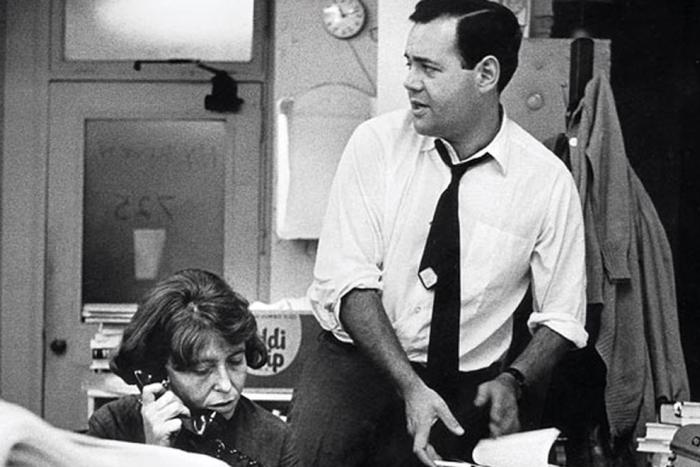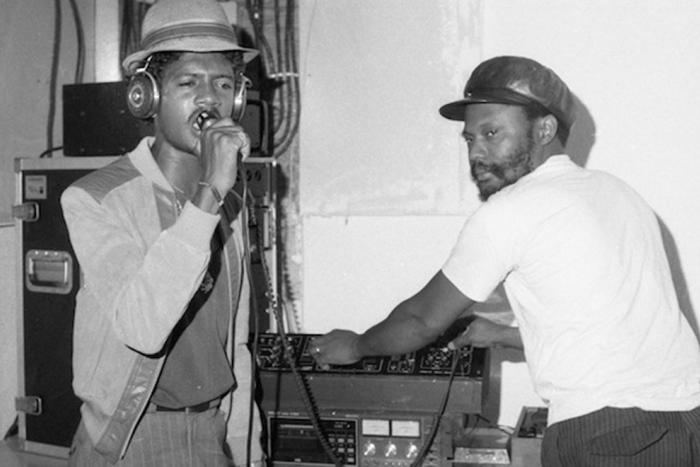Over the past two decades, the art curator Hans Ulrich Obrist has conducted and recorded more than 2,000 hours of conversations in service of his Interview Project. It’s an archive he will continue to grow throughout his life and it contains dialogues with the world’s leading artists, thinkers, architects, scientists, engineers, musicians, and writers. He has likened his mission to that of radio host, Studs Terkel, who, at his death in 2008, had collected 10,000 hours of oral histories.
Obrist is currently, hands down, the world’s most prominent curator. He is the co-director of the museum-sized Serpentine gallery in London, a contributing editor at 032c magazine and a founder of the Brutally Early club, a loose group of culturally active types who meet in coffee shops at dawn around the world. He has a blazingly peripatetic lifestyle: “From 1991 to 2000 I was nomadic,” he says. “I travelled 300 days a year.” He lectures internationally, lives bi-continentally, and attends what seems like every art fair and biennial. Three years ago, at the age of 41, he was dubbed the most powerful person in the art world by ArtReview magazine.
In school, Obrist studied social studies and politics. He discovered his love for art in his early 20s, through two now-classic books of interviews: Brutality of Fact: Interviews with Francis Bacon by David Sylvester and Dialogues with Marcel Duchamp by Pierre Cabanne, both in-depth, long-term conversations on the career of an enigmatic subject. “These books somehow brought me to art,” he has said. “They were like oxygen, and were the first time that the idea of an interview with an artist as a medium became of interest to me. They also sparked my interest in the idea of sustained conversations—of interviews recorded over a period of time, perhaps over the course of many years; the Bacon/Sylvester interviews took place over three long sessions, for example.”
Marina Abramovic, the endurance-performance artist, described Obrist as “sleepless, restless, obsessed, possessed, art, olympic, runner, volcanic, mind-blowing, limitless.”
Obrist has placed himself in the lineage of Cabanne and Sylvester, and interviews his subjects repeatedly (e.g. Jeff Koons and Phillipe Pareno). He views his work as that of a relentless archivist, and carries his video camera with him constantly, never certain when an interview may begin. (Filmmaker Jonas Mekas inspired him to use a camcorder, rather than an audio recorder, for documenting his talks.) Obrist also finds inspiration in Andy Warhol, who compulsively recorded his own life on a tape recorder and founded Interview; and, of course, Terkel, who once gave him tips about embracing the art of imperfection in an interview. As with his predecessors, excerpts from Obrist’s project are often released in print, and become transposed from oral history to literature. His publications, so far, include two 1000-page anthologies, HuO: Hans-Ulrich Obrist: Interviews vol.I-II, and the 21 volumes released as a series by Walther Konig Books: novella-length interviews with artists including John Baldessari, Robert Crumb, Wolfgang Tillmans, and Rosemarie Trockel. But much of the project remains unpublished.
As an interviewer, Obrist is no longer an anonymous question-pepperer but a figure who is often better-known than his subjects. Like Charlie Rose, Barbara Walters, and James Lipton, his personality (and project) is inextricably present in the interview. Marina Abramovic, the endurance-performance artist, described Obrist as “sleepless, restless, obsessed, possessed, art, olympic, runner, volcanic, mind-blowing, limitless.” When he lectures, he appears incapable of stillness, his hands dancing in front of him, his weight shifting from foot to foot, his shoulders pumping like eyebrows, adding emphasis to every phrase. He speaks quickly, in a thick Swiss-German accent, and has the look of a brainy scientist: semi-transparent glasses and puffs of cotton candy hair atop a gleaming melon of a head.
*
Obrist has said that interviewing cultivates empathy and allows him “slowness.” He seems earnestly consumed by conversation. He smiles as he questions, a perpetual, somewhat purposeful-looking grin that might just be the way his mouth is formed. He is never at a loss for words. For a voracious student of culture, the interview is an opportunity to listen and ask without the need for production or the weight of profession: interviewing generates just enough money to cover his transcription fees.
Before an interview, Obrist likes to get to know his subjects informally and formally. He socializes with artists, an act uncommon among many curators, and reads everything he can find about a person’s work. Then the interview itself begins, extemporaneously: after few friendly conversations, once the “atmosphere is there,” Obrist will place his handheld video camera on its little tripod, point it at his subject and through dialogue, try “to understand the forces effective in visual arts” (a phrase he uses often). “At some point during the interview I very often throw overboard a lot of the preparations and go into freestyle,” he says, “but I can do it because I’m prepared and if I don’t prepare I don’t have the confidence to do that, so I need to over prepare to then be free.”
Obrist views the art world as the contemporary equivalent to Sergei Diaghilev’s view of ballet in the early 20th century: a receptive venue to all the arts.
He seeks to discuss topics the interviewee hasn’t discussed publicly—for example, his interview with Gerhard Richter on the subject of architecture. He almost always asks about an unrealized project. “A lot of practitioners have unrealized dreams which they would like to realize but of which they never talk,” Obrist says. “I’ve very interested in this idea. ‘What actually are our dreams?’ Because that can make them happen. That is the only recurring question in all my interviews.”
In 2005, Obrist began the Marathon interview series, an event in which 50 public interviews are conducted, often for 24 non-stop, sleepless hours. Some of the marathons have been co-conducted by architect Rem Koolhaus, with whom Obrist has an ongoing dialogue. The marathon’s format was “inspired by open air music festivals—the idea being that people would come and go and fall asleep and the conversation would always be going,” and Obrist has held poetry marathons, map marathons, manifesto marathons, and experiment marathons using the same format (though not all marathons are 24 hours long).
Obrist views the art world as the contemporary equivalent to Sergei Diaghilev’s view of ballet in the early 20th century: a receptive venue to all the arts. The art world is often thought to be an insular, elitist place, and in many ways this is undeniable: the thick, inscrutable rhetoric in Artforum and artist statements seems cogent only after its reader has attended a graduate program in art history; and any art work of moderate interest is available only to a very small population with a very large, very disposable income. But images themselves are democratic, galleries are free to all, and in the last century, art has become an impossibly inclusive term: sculpture, design, film, music, dance, new media, philosophy, and countless performance styles exist comfortably under its umbrella.
“From art I went into science,” Obrist says, “from art I went into music; from art I went into literature; from art I went into architecture. And gradually it is like a concentric circle, it goes from the art world to all these other worlds, and then, from there, it goes into the multitude.”
In his view, curation can include all disciplines, venues, and approaches. Fittingly, Obrist’s first exhibition was birthed from an interview: after a three-way discussion on expanding boundaries in curation with the artists Fischili and Weiss, Obrist decided to curate a show with the duo inside his Berlin apartment. Since then, he has shown Christian Boltanski in airplanes and Gerhard Richter in Friedrich Nietzsche’s house. He organized a “conference with no conference,” which he describes as one long coffee break, and he curated Do It, a traveling exhibition in which artists provided instructions for works that could be installed by anyone, anywhere. Obrist’s new Marathon series are a push against the organization of space and objects—what gallery curation normally is—and an attempt to curate “temporalities.”
The first Marathon occurred in Stuttgart, and events have followed in Berlin, Beijing, and London, the last of which is being released in a 376-page book, The London Dialogues. It reads like pure documentation, a long stream of Q&As. While precise time is given for each conversation (an example of Obrist’s attention to temporality), there are no introductions for any of the interviewees—no info on their professions or areas of expertise. Ultimately, the subject is not the interviewee, but London. Obrist wants to “make a portrait of a city” and the book is presented as a continuous, uninterrupted conversation on this topic—a marathon for Obrist; a relay for the subjects, who pick up where the previous conversation left off.
Though the interviews appear like documentation, they do seem edited. Utterances of “uh” and “like” and “um” are missing from all speech, a phenomenon that, even among the well-spoken art-class of London, seems dubious. This is only to say that the book is not pure, unadulterated documentation, but a refined literary object. While Warhol’s transcribed novel, A, was unedited to the point of unreadability, London Dialogues is a cultural text to be read, used, referenced. (Warhol’s novel was so pure that it could only be read as a manifestation of an ideology.) Obrist is a passionate reader and knows that for the act of reading to be successful, the content must be shaped and served cleanly.
Most likely, the readability of his archive will be Obrist’s most lasting achievement. Two-thousand hours of interviews marks only the start of the project, and as those interviews are quoted and excerpted, the Interview Project will see its rebirth in monographs and biographies and academic texts in every field. His documentation will become fact, and his field will swell to embrace the curation of history.






